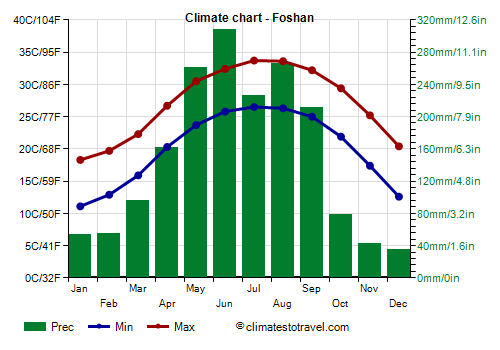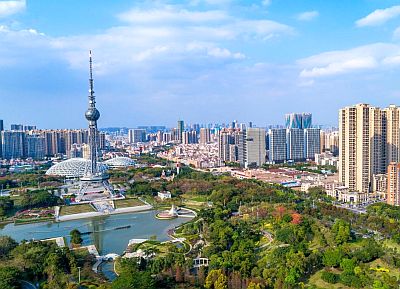Select units of measurement for the temperature and rainfall tables (metric or imperial).
Average weather, temperature, rainfall, sunshine hours

The climate of Foshan is
subtropical, with very mild winters and hot, rainy and muggy summers due to the Asian monsoon.
The city is located in southern China's Guangdong Province and just south of the Tropic of Cancer.
We are in the vast area of the Pearl River Delta. To the east are Guangzhou and Dongguan, and to the south Macao, Shenzhen and Hong Kong.
Here are the average
temperatures.
Foshan - Average temperatures (1991-2020) |
| Month | Min | Max | Mean |
|---|
| January | 11.1 | 18.3 | 14.7 |
|---|
| February | 12.9 | 19.7 | 16.3 |
|---|
| March | 15.9 | 22.3 | 19.1 |
|---|
| April | 20.3 | 26.7 | 23.5 |
|---|
| May | 23.7 | 30.5 | 27.1 |
|---|
| June | 25.8 | 32.4 | 29.1 |
|---|
| July | 26.5 | 33.7 | 30.1 |
|---|
| August | 26.3 | 33.6 | 30 |
|---|
| September | 25 | 32.2 | 28.6 |
|---|
| October | 21.9 | 29.4 | 25.6 |
|---|
| November | 17.4 | 25.2 | 21.3 |
|---|
| December | 12.6 | 20.4 | 16.5 |
|---|
| Year | 20 | 27.1 | 23.45 |
|---|
is abundant, in fact, it is around 1,800 millimeters (71 inches) per year. The rainiest period is from April to September, when rainfall exceeds 150 mm (6 in) per month, while the least rainy period is from November to February, when it drops below 60 mm (2.4 in) per month. Here is the average precipitation.
Foshan - Average precipitation| Month | Days |
|---|
| January | 53 | 7 |
|---|
| February | 54 | 9 |
|---|
| March | 96 | 14 |
|---|
| April | 162 | 15 |
|---|
| May | 261 | 17 |
|---|
| June | 308 | 18 |
|---|
| July | 227 | 16 |
|---|
| August | 266 | 16 |
|---|
| September | 211 | 12 |
|---|
| October | 79 | 5 |
|---|
| November | 42 | 6 |
|---|
| December | 35 | 6 |
|---|
| Year | 1795 | 142 |
|---|
, from December to February, is very mild, with highs around 18/20 °C (64/68 °F). The sun, which shines roughly half the time in December, gradually becomes less frequent, and the number of days with cloudy skies, fog and drizzle increases. There may also be windy days. Some days can be pleasantly warm, while in others, the temperature can drop to around 10/15 °C (50/59 °F) during the day, and the wind can increase the feeling of cold. Occasionally, it can even get cold, with lows close to freezing and highs around 10 °C (50 °F).
Spring, from March to May, is very mild or pleasantly warm, but the sky is almost always cloudy. In March, a cold wind can still blow, and highs can remain around 13/15 °C (55/59 °F), especially in the first half of the month. By mid-March, with the increase in temperature, the first thunderstorms occur. Already in May, there's sultry heat, with highs around 29 °C (84 °F), even though it's less intense than in the summer months; moreover, the rains become significant.
The long
summer, from June to September, is hot, humid and rainy, with heavy showers or thunderstorms, although the sun shines on average for a few hours per day. Typically, daytime temperatures are around 32/34 °C (89/93 °F), but they quite easily reach 35/36 °C (95/97 °F). The heat is felt because of the urban heat island effect, together with moisture coming from the sea. Luckily, there is widespread use of air conditioning. Usually, the heat remains muggy even at night: lows rarely drop below 23 °C (73 °F), but they can even remain around 26/27 °C (79/81 °F). In the hills around the city and in the cities of the metropolitan area near the sea, at least sea breezes blow. In July, there is often a pause in the monsoon, a period of good weather lasting a week or two.
The probability of typhoons, which bring heavy rains and strong winds for a few days, with the risk of flooding and landslides, is highest in this season.
In the short
autumn, in October and November, the rains are rare and generally not abundant, and the sun is a bit more frequent than in the other seasons. In the first part of October, the heat can still be muggy, but gradually becomes more pleasant; in this month, however, and sometimes also in the first half of November, tropical cyclones can still arrive. In November, the temperature is generally pleasant, with highs around 25 °C (77 °F), but cool and windy days gradually become more likely, and sometimes, in the second part of the month, it can get a bit cold.

The amount of
sunshine in Foshan is not great all year round, and it's scarce from February to April, when the sky is often overcast. In the rainy season, it improves a little, in fact, there is an alternation between sunshine and cloud banks, which can lead to showers and thunderstorms. In autumn, the amount of sunshine remains acceptable or improves slightly, however, cloudy days are possible in this season as well. Here are the average sunshine hours per day.
Foshan - Sunshine hours| Month | Average | Total |
|---|
| January | 3.5 | 105 |
|---|
| February | 2.5 | 75 |
|---|
| March | 2 | 60 |
|---|
| April | 2.5 | 75 |
|---|
| May | 3.5 | 110 |
|---|
| June | 4.5 | 135 |
|---|
| July | 6 | 180 |
|---|
| August | 5.5 | 170 |
|---|
| September | 5 | 155 |
|---|
| October | 5.5 | 170 |
|---|
| November | 5 | 150 |
|---|
| December | 4.5 | 140 |
|---|
| Year | 4.2 | 1525 |
|---|
The
sea is warm enough for swimming from April to November, and in particular, it's definitely warm from May to October. In winter, the South China Sea is cool but not cold: the water temperature drops to around 20 °C (68 °F) in January and February.
Foshan - Sea temperature| Month |
|---|
| January | 20 |
|---|
| February | 20.5 |
|---|
| March | 21.5 |
|---|
| April | 23 |
|---|
| May | 26 |
|---|
| June | 28 |
|---|
| July | 29 |
|---|
| August | 29 |
|---|
| September | 28.5 |
|---|
| October | 26.5 |
|---|
| November | 24"> |
|---|
| December | 21.5 |
|---|
| Year | 24.8 |
|---|
Typhoons
As mentioned earlier, Foshan can be hit by typhoons, the tropical cyclones of Southeast Asia. Typically, typhoons occur in this area from June to early November, but sometimes they have affected this area outside of this period, as happened in April 2008 with Typhoon Neoguri (or Ambo) and in May 2006 with Typhoon Chanchu (or Caloy).
Best Time
It's not easy to find the
best time to visit Foshan. Winter can be a good period, although the sky is often cloudy, especially in the second part; moreover, it can be windy, and sometimes, though rarely, it can be a little cold. Spring is pleasantly warm, but it's still cloudy, and when the sun becomes a little more frequent, the rains begin as well, then by May, the air is muggy and there is some risk (though still low) of typhoons. In theory, autumn is the best season, but in October, a typhoon can still affect this area, while in November, there can be the first cool and windy days, and sometimes at the end of the month, it can already be a bit cold. All in all, the best times are from mid-March to mid-April, and from mid-October to late November.
What to pack
In winter: bring spring/autumn clothes, a sweatshirt or sweater, a jacket, a raincoat or umbrella, and a hat for colder days.
In summer: bring tropics-friendly, lightweight clothing, a light sweatshirt for air-conditioned places, and a light raincoat or umbrella.